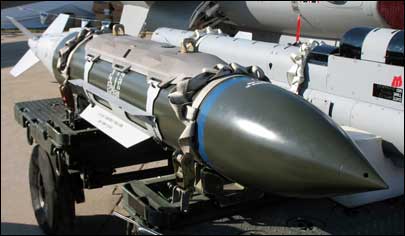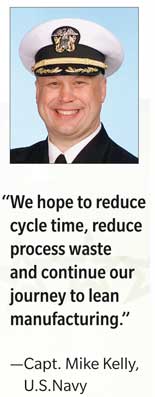Apr 01, 2009For the past 15 years, the U.S. Department of Defense (DOD) has been fighting a war to root out inefficiencies in its supply chain, the largest and most complex in the world. The goal: to make sure troops around the world have the correct arms, medicines, food and clothing when needed, by eliminating waste, improving services and bolstering security. The weapons of choice in this war against inefficiencies: active and passive radio frequency identification technologies.
After the Gulf War in Iraq in the early 1990s, the DOD developed an active RFID-based cargo tracking system—called the RF In-Transit Visibility (RF-ITV) network—to remedy logistics problems; the vast majority of some 40,000 containers shipped overseas had to be opened to determine what was inside, and many held redundant supplies. The RF-ITV now has nodes in more than 40 countries and 4,000 locations, and tracks an average of 35,000 supply shipments per day around the world. In hindsight, the U.S. General Accounting Office (now the Government Accountability Office) estimated that the RF-ITV system would have saved about $2 billion worth of inefficiencies during the Gulf War.
The DOD has pushed for international RFID standards and has been an influence on other governments and organizations. Australia, Poland, Spain, the United Kingdom and NATO are among the international forces that have been deploying the RF-ITV system over the past few years for real-time visibility of national and multinational shipments.
On another front, more than 4,000 DOD suppliers are attaching passive RFID tags to pallets of goods, so they can be automatically received into inventory, easily located in warehouses, and more accurately tracked during shipment to military bases or conflicts overseas. The DOD's requirement for its suppliers to use passive RFID tags on each pallet they ship to depots operated by the Defense Logistics Agency (DLA), the DOD's logistics arm, has convinced some of those suppliers to internalize the use of RFID—and to ask some of their own suppliers to RFID-tag their shipments.
The DOD is now aiming RFID at inefficiencies in services and vulnerabilities in security. For example, the U.S. military is RFID-tracking aircraft parts to shorten turnaround times for repair and maintenance, reducing costs and better serving pilots in the field. In addition, often paired with GPS and/or sensor technology, RFID is being employed to tamper-proof weapons and sensitive shipments sent to troops in far-flung locales, such as Afghanistan or Iraq.
The DOD has budgeted approximately $877.6 million for automatic identification technology from fiscal years 2010 to 2015, according to Alan Estevez, the department's principal assistant deputy undersecretary of defense, who has been the point person on RFID. The majority of the budget is for sustaining the RF-ITV system.
"At the end of the day, the government, and particularly the defense wing of the government, remains a key driver in terms of RFID adoption," says Michael Liard, RFID practice director at ABI Research. "If you look at the military's role in RFID historically, I expect that positive trend to continue in the foreseeable future. The interesting thing about government is that, in tough economic times, usually those budgets have been already allocated. In private business, they can elect at any time to back away or re-prioritize."
The RF-ITV system is now fully deployed by all the U.S. armed services branches for cargo shipments around the world, and it's being used increasingly by NATO and other U.S. allies to allow continued visibility through foreign ports for both U.S. and international supplies. The results have helped the DOD maintain visibility into shipments for the two ongoing conflicts in Iraq and Afghanistan, for both outbound and return shipments.
"We have much more ability to effectively distribute and manage the cargo where it's needed and when it's needed," says David Shannon, senior VP at Savi Technology (a subsidiary of Lockheed Martin), which has been the main technology supplier for the RF-ITV system. "We don't have to flush the area and just send stuff in. We can be more selective. And when someone has an urgent need, we have visibility. We know where the cargo was last seen. That's a huge advantage."
In 2003, the DOD realized that in order to create a more automated and sophisticated end-to-end supply chain, it needed to push the RFID tagging of supplies back to the point of origin—the DOD's commercial suppliers. In September 2004, the department formally adopted rules and issued an information guide to suppliers, requiring many to begin using passive RFID on pallets or containers of goods being shipped to the DLA.
In October 2008, a report by the DOD's Office of Inspector General stated that if the DOD wanted to achieve a return on investment from its $12.2 million investment in passive RFID, it would need to improve compliance with its RFID mandate among suppliers. The report found that about 10 percent of audited contracts with suppliers did not include RFID requirements. And when inspectors audited shipments from those suppliers that did have contractual obligations to RFID-tag goods, 43 percent had failed to attach RFID tags to their shipments.
"We're looking at the results of that and are moving to correct the issues they raise," says the DOD's Estevez. But, he adds, it's a situation where the glass can be seen as half empty or half full. The report found that more than half of the audited shipments were being RFID-tagged, and that 90 percent of the contracts did include tagging requirements.
"We're still in the early stages," Estevez says of the DOD's passive RFID program. "While we have our defense depot system pretty much rolled out, we really are just beginning our journey when it comes to rolling it out to tactical units. And frankly, that's where the big payoff is."
But the rollout of both passive and active RFID by the four branches of the U.S. armed services—the Air Force, Army, Marines and Navy—as well as by NATO allies is expected to broaden even further due to recent agreements on standards and the awarding of new contracts for RFID technology and services. While the DOD historically has relied on one contractor, Savi Technologies, for active 433.92 MHz RFID technology, Savi has agreed to license its technology to other vendors under the development of the international ISO 18000-7 standard, opening the door to more competition.
In January 2008, the DOD awarded a $428 million contract that allows various military branches, NATO allies and coalition partners to purchase active RFID hardware, software and services from four vendors—Northrop Grumman Information Technology, Savi, Systems & Processes Engineering, and Unisys. In October, the DOD awarded contracts for $75.5 million worth of passive RFID products and services from six vendors—CDO Technologies, CODEplus, Lowry Computer Products, Northrop Grumman, ODIN Technologies and SYS-TEC.
"For the first time, that contract allows anyone in the DOD or our NATO allies to buy a complete passive RFID solution off a single contract—for hardware, software line items and services line items," says Bret Kinsella of ODIN Technologies. "It's been important for the DOD to put this in place to make it easier for people to procure not only hardware and software, but services as well."
The U.S. armed services are finding that they can achieve savings in labor and inventory by tracking parts for use in the maintenance and repair of vessels, from nuclear submarines to fighter jets. Parts tracking can also help cut turnaround time at repair centers, ensuring vessels get back out in the field on schedule.
In March 2006, the Navy began considering RFID parts tracking for the Fleet and Industrial Supply Center (FISC) in Bremerton, Wash., which repairs and services Trident nuclear submarines operating out of the Naval Base Kitsap Bangor in nearby Silverdale. The FISC comprises 300,000 square feet of warehouse space and receives an estimated 6,000 stock replenishments and new parts each month. These supplies used to be received manually, which was labor-intensive and prone to errors. Now, receiving RFID-tagged parts from DLA depots, the Navy has found that the time between receiving items and when they are made visible in inventory has been cut by 3.6 days, and submarine and repair shop customers have seen the wait time for items in stock decrease by nearly 2.5 days.
Prior to initiating the Bangor RFID Evaluation (BRE) project three years ago, the Navy had conducted a business case analysis (BCA) that predicted the project would see a return on investment within three years. "As a validation measure, a follow-on BCA ROI was completed in December 2008 that revalidated the original BCA findings," says Bob Bacon, director of the Navy Automatic Identification Technology program office. "Approximately one-third of the BRE savings were associated with labor, while the other two-thirds were associated with inventory."
The Navy's Fleet Readiness Center in Coronado, Calif.—an 85-building facility that is one of six U.S. centers where the Navy services fixed-wing and rotary aircraft—is working with EDS, an HP company, to develop an RFID tracking program supported by a wireless infrastructure. The goal of the program, which is slated to begin this summer, is to help some of the center's nearly 2,000 workers more easily store and locate parts when F-18 fighter jets come in for their regular servicing. During that servicing, which occurs every eight years for each jet, the planes are disassembled into roughly 1,000 parts, some of which need to be repainted and serviced or replaced.
"We hope to reduce cycle time, reduce process waste and continue our journey to lean manufacturing while making sure our [facility] is staffed with parts they need, when they need it, to keep parts and aircraft flowing through the plant," says Capt. Mike Kelly, commanding officer of the Fleet Readiness Center.
Gary Parent, the EDS consultant on the project, says the RFID tracking program—which will involve applying tags to parts as they are disassembled—is being combined with a wireless network to provide real-time locating for parts, so that anyone at a desktop or with a wireless computer on the floor can determine the coordinates of a part for easy accessibility. Parent expects to be gathering information from a pilot at the Fleet Readiness Center for six months, and says EDS has designed the project so it can be deployed at any of the Navy's other centers, with enhancements determined by the data gathered from the pilot.
Other service branches also are using RFID to track assets, from laptop computers to tools. The U.S. Army National Guard last year RFID-tagged 10,000 assets, including computers and printers, at its 12-story headquarters in Washington. Meanwhile, at Georgia's Robins Air Force Base, a tool-tracking project that initially tagged 25 gyroscopes in 2006 has been expanded to include RFID tracking of 15,000 tools and other assets. The Air Force Global Enterprise Tracking (AFGET) system has been adopted by five other Air Force facilities.
The DOD has recently started tagging the containers of nuclear weapons components stored at Hill Air Force Base in Utah, Estevez says. The decision to track those components with RFID comes after the revelation in March 2008 that four ballistic missile electrical fuses from that base had been mistaken for helicopter batteries and sent to the government of Taiwan. The mistake, made in 2006, wasn't noticed until the Taiwanese realized they had been sent the wrong equipment. "We've established a policy to use RFID to manage the facilities where those components are stored and other classified material," Estevez says. "We believe that RFID will help us better manage that facility."
Several projects currently under discussion or in testing seek to pair RFID with other technologies, such as sensors or GPS, to track supplies in remote areas, such as through some of the more hazardous land journeys into Afghanistan. That tracking could involve a GPS unit equipped with an RFID interrogator that can read the RFID tags on the containers or trailers and communicate via satellite the GPS position of those goods. These trials are now in the proof-of-concept phase. Savi's Shannon says such tracking is valuable not only for sensitive shipments, such as weapons, but for common shipments such as food that might be a very valuable commodity to thieves. At the same time, he says, pilots are under way to test RFID in conjunction with sensors to detect whether security was breached during shipment—for example, if a container door was opened.
The next task, officials say, is for the DOD to better utilize the data it's receiving, particularly from passive RFID reads. Last year, Boeing acquired two software companies, Federated Software Group and Tapestry Solutions, in an attempt to help customers like the DOD meet their needs in interpreting the data collected from RFID tags. "The guy using that data wants to know where it's been, where it is and where it's going," says Steve Georgevitch, deputy of the logistics command and control group at Boeing Integrated Defense Systems, the aerospace giant's defense arm. "We're able to take different pieces of information and help present it to that person in a visual or map-based form. On the map, he can see 'where is my stuff,' so he can get a better understanding of when it's going to get here and when it's going to leave here."
The DOD is now beginning to analyze business processes using RFID data. "Reading an RFID tag creates new data points that enable us to measure various segments of our order-fulfillment process with greater accuracy," Estevez says. "We are already gaining key insight to process improvement opportunities and visibility of orders." The department plans to expand this capability to top-volume military customers, working to improve visibility and reduce "customer wait time" (the time from when the DOD unit orders an item to when the item is delivered) and associated inventory investment. The DOD is also working to refine its receiving process and reduce procurement lead times and inventory levels by using the RFID data captured from incoming vendor shipments to improve visibility.
"It comes down to how quickly I can receive material, how well I can store it, do I know what I have, and can I keep better track of the material in this vast system," Estevez says. "When I start using that data, I can better manage using that inventory for the benefit of our operating forces and for the benefit of the American taxpayer."
So where does the DOD stand in the war against supply-chain inefficiencies? "The DOD's goal is to implement 'knowledge-enabled logistics,'" Liard says. "Put simply, the DOD is using RFID to win the supply-chain optimization war. Utilizing RFID and other related technologies to automate routine functions gives the DOD more accurate and timely in-transit visibility across its prolific supply chain, as well as in-storage and repair asset visibility with the least possible amount of human intervention. In our opinion, the DOD is winning that war one battle at a time through continued RFID program extension. However, the supply-chain optimization war is expected to be waged over many years to come."
Under a mandate from the U.S. Department of Defense, some 4,000 suppliers—from small businesses to large companies—are required to attach passive RFID tags to pallets of goods shipped to depots operated by the Defense Logistics Agency, the DOD's logistics arm. Many suppliers view the tagging mandate as the cost of doing business with the DOD.
"By and large, most suppliers have not yet decided to utilize RFID in-house for inventory control, work-in-process tracking and so on," says Robert Steinberg, president of Productivity by RFID, a consulting firm that helps DOD suppliers, ranging from a seven-employee machine-tool outfit to GE, with compliance issues. "What they're doing is buying small, stand-alone systems or printing and encoding labels themselves." Other suppliers, he says, are outsourcing the RFID labeling, including to his firm's subsidiary, Compliance Label Service.

Nav-Aids, a small Montreal-based manufacturer of test accessory kits used for onboard aircraft systems, spent $10,000 on RFID equipment in 2007 so it could tag the low volumes of products it ships to the DOD each year. The company is also RFID-tagging shipments to other governments and organizations, including Canada, the United Kingdom and NATO. "Because we're able to comply and do it in-house, it keeps our costs down," says Robert Marshall, quality program manager at Nav-Aids.
Marshall says his company sees the potential in using the RFID data inside its business, but thus far it hasn't had the time or staff—Nav-Aids has only 15 employees—to devote to that. "I can see where it could become a very effective means of inventory control," he says. "As you bring stuff in from suppliers, whether it's materials or parts, and when those supplies are withdrawn from stock to be put into product, it would be a piece of cake to maintain."
But some larger suppliers with more resources are working to incorporate RFID into their operations, and are even asking their suppliers to RFID-tag shipments so that goods can be tracked from their source. Boeing, for example, is working on a project with the U.S. Navy to tag shipping containers for Joint Direct Attack Munition (JDAM) kits, which convert unguided gravity bombs, or "dumb bombs," into "smart bombs" that use technology to find their targets.
"One of the components we use [in the kits] is from Lockheed Martin," says Steve Georgevitch, deputy of the logistics command and control group at Boeing Integrated Defense Systems. "We have a system where they deliver their product with tags on it, and we bring it into our supply chain and the component becomes part of that JDAM kit."
Some companies are hesitant about investing in RFID because of the economy. "Clearly, if the economy were better," Steinberg says, "more corporate funds would be available on productivity-improvement projects."



